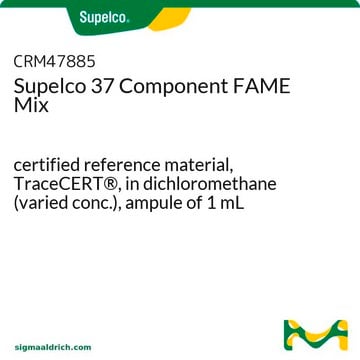171476
Undecanoic acid
98%
Synonym(s):
Hendecanoic acid
Sign Into View Organizational & Contract Pricing
All Photos(2)
About This Item
Linear Formula:
CH3(CH2)9COOH
CAS Number:
Molecular Weight:
186.29
Beilstein:
1759287
EC Number:
MDL number:
UNSPSC Code:
12352100
PubChem Substance ID:
NACRES:
NA.22
Recommended Products
Quality Level
Assay
98%
form
solid
bp
228 °C/160 mmHg (lit.)
248-250 °C (lit.)
mp
28-31 °C (lit.)
functional group
carboxylic acid
SMILES string
CCCCCCCCCCC(O)=O
InChI
1S/C11H22O2/c1-2-3-4-5-6-7-8-9-10-11(12)13/h2-10H2,1H3,(H,12,13)
InChI key
ZDPHROOEEOARMN-UHFFFAOYSA-N
Looking for similar products? Visit Product Comparison Guide
Application
Undecanoic acid was used in the formation of cycloamylose crystals.
Storage Class Code
11 - Combustible Solids
WGK
WGK 1
Flash Point(F)
>233.6 °F
Flash Point(C)
> 112 °C
Personal Protective Equipment
dust mask type N95 (US), Eyeshields, Gloves
Choose from one of the most recent versions:
Already Own This Product?
Find documentation for the products that you have recently purchased in the Document Library.
Customers Also Viewed
Rashanique D Quarels et al.
Beilstein journal of nanotechnology, 8, 1863-1877 (2017-10-20)
Visible-light irradiation of phthalimide esters in the presence of the photosensitizer [Ru(bpy)
Nicole Lindenkamp et al.
Applied and environmental microbiology, 78(15), 5375-5383 (2012-05-29)
β-Ketothiolases catalyze the first step of poly(3-hydroxybutyrate) [poly(3HB)] biosynthesis in bacteria by condensation of two acetyl coenzyme A (acetyl-CoA) molecules to acetoacetyl-CoA and also take part in the degradation of fatty acids. During growth on propionate or valerate, Ralstonia eutropha
Jorge Almodóvar et al.
Biotechnology and bioengineering, 110(2), 609-618 (2012-08-21)
Cortical bone allografts suffer from high rates of failure due to poor integration with host tissue, leading to non-union, fracture, and infection following secondary procedures. Here, we report a method for modifying the surfaces of cortical bone with coatings that
Joseph J Pesek et al.
Journal of chromatography. A, 1216(7), 1140-1146 (2009-01-13)
The use of silica hydride-based stationary phases for the retention and analysis of nucleotides has been investigated. Both reversed-phase columns with a hydride surface underneath as well as those with an unmodified or a minimally modified hydride material were tested.
N Nath et al.
Journal of the American Chemical Society, 123(34), 8197-8202 (2001-08-23)
The change in optical properties of colloidal gold upon aggregation has been used to develop an experimentally convenient colorimetric method to study the interfacial phase transition of an elastin-like polypeptide (ELP), a thermally responsive biopolymer. Gold nanoparticles, functionalized with a
Our team of scientists has experience in all areas of research including Life Science, Material Science, Chemical Synthesis, Chromatography, Analytical and many others.
Contact Technical Service










